|
 For almost two years, Rosa Roedelius has been working on sculptures and objects called “the objects of playing”. These works represent buildings the artist invented to dream and live the day. “They can be interpreted as playgrounds for the eye and offer opportunities to approach games,” the artist explains. “The objects are parts of stories that happened in the past or that will take place in the future. There is something you could call a playful looking that may open a whole new world.” For almost two years, Rosa Roedelius has been working on sculptures and objects called “the objects of playing”. These works represent buildings the artist invented to dream and live the day. “They can be interpreted as playgrounds for the eye and offer opportunities to approach games,” the artist explains. “The objects are parts of stories that happened in the past or that will take place in the future. There is something you could call a playful looking that may open a whole new world.”
 These works were recently exhibited at the Museum for Applied Arts in Vienna and the exhibition at the Beatrice Wood Center for the Arts represents their U.S. debut. The objects are intriguing because of their individual haptic impression, the different attractive surfaces and their poetical and waggish expression. These works were recently exhibited at the Museum for Applied Arts in Vienna and the exhibition at the Beatrice Wood Center for the Arts represents their U.S. debut. The objects are intriguing because of their individual haptic impression, the different attractive surfaces and their poetical and waggish expression.
“While creating, I see materials, things that surround me, I feel their certain character and force them to tell my stories,” Roedelius says. “Important for my work is my dreamlike certainty, that solves and expresses my formal and aesthetical questions.
The main focus of the Rosa Roedelius exhibition at the Beatrice Wood Center of the Arts will be on the players and inhabitants that surround the objects of playing. Faces will be shown in different emotions. Their expressions will show who they are, how it feels to be like them and where they live. The masks and objects are made of material such as paper, glass, wood, clay and metal, which are all essential tools in our lives to achieve our individual goals.
“I take a close look at their social circumstances and freeze their movement towards the pursuit of happiness,” Roedelius explains. “Every step further starts with a moment of silence, a blink of an eye before the next action takes place and opens a new possibility - to win or lose.”
“Isn´t it at the same time the beholder´s expectations, which make him or her realize and see, what his or her own struggles and experiences of life are and what his or her face may look like in this very special moment of being?” The artist asks. “What is it worth endeavouring after as we know the ending of all such attempts? Do we truthfully know the ending?”
“This secret dialog between “the players” and the visitors is my covert goal,” Roedelius says. “The confidential talk about the meaning of life.”
__________________________________________
By Leo Hemetsberger, PhD
Rosa Roedelius studied arts, particularly painting and sculptures at the University of Applied Arts in Vienna, and attained her MA with Honors. But this was only the final exam in a journey, which began in early childhood. At two years of age, guided by her mother, Rosa walked along the top of an old wall; where she squatted down to examine something of interest there. Touching it softly with her hand, and repeating her mothers explanation of what it was; moss, ("moos" in German), she said. This is the first word Rosa remembers speaking, the verbal expression of a haptic impression. As every human being has his own individual talents, Rosa is strongly visually and haptic orientated, and that is how she explores the world as an artist.
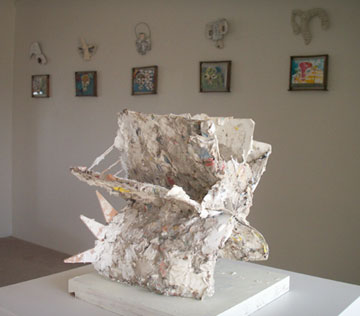
Installation View with I Took the Statue of Liberty's Crown
Rosa Roedelius already had several exhibitions in Austria and Germany and received honors and prizes during her studies. In 2007 she presented art in two open space projects. The first, a nineteen-foot high tower, filled with film transparencies, was called the lighthouse - sound cloud. Her father, Hans Joachim Roedelius, composed a 12 hour-long sound installation to accompany this work, which reflected the relationship between human individuality and the social conditions into which all of us are embedded, their interaction with the surrounding space and the moving of light during day and night, which forms our experience of time.
The second installation in open space was a 65 feet long and 32 feet broad arrow of wood, symbolizing the borders of states and the borders in our minds. The human arrow was filled with 23 more than life sized white-colored wooden figures, running from south to north. This installation reflected the transmigrations problems in Europe and the world. This installation regarding refugees was destroyed by unknown persons, which might have been upset about the background of this art project.
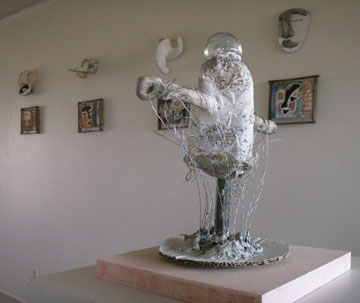
Installation View, with Encompasses Filled
The Players: Where to Live, Who to Be is Rosa Roedelius’ first exhibition in the US, and reflects a relationship with the artists Cy Twombly and Kiki Smith. It is a conceptual installation, which is best-read split into different circles, like the fingers of the hand, with the thumb and centerpoint the sculpture called Fairy Tale Tower in the center of the room.
The 1st circle around the Fairy Tale Tower are the four other sculptures, which symbolize the environment, where this tales of life are taking place.
The work titled Encompasses Filled stands for the endless possibilities of the human mind, the Harp Partridge for the living beings, the sculpture I Took the Statue of Liberty's Crown as a symbol of the political circumstances we have to solve, and the Teeterboard-Shell, which has a very special relation to the artist, it symbolizes the water and the ocean, where we can feel free to move in all three dimension of space, and the source of all life.
|
 Fairy Tale Tower
Fairy Tale Tower
|
Click images for larger view:
In the installation, you can draw a cross line through the tower between the two opposite objects, which are related to each other. So this is it about the environment.
The 2nd circle is the circle of behaviour and abilities, the actions, which are forming our world, as we know it.
This circle is the only one which is drawn eccentrically, because every action is a unique definition of the human freedom, it breaks through the wall of determination, our free will is, as Immanuel Kant said, a basic fact and sine qua non of mankind, which is experienced by every child. In this circle you can see 8 single objects, with titles like Control, Donation, Gone with the Wind, Possible Offspring, Lust, Youth, and one consisting of two parts, female and male.
Click images for larger view:
These object represent the abilities we discover, the talents we build up, our bodies, how we live our sexuality, the methods and tools we are using in general, to reach - what?
The goals - are our individual goals, yet those that are always common too. Living in a world where individuality is inseparably connected to the economic systems, where all of our desires are almost immediately fulfilled, through well-designed and practical objects. But in the same moment, when we are using them, they open up their inner life, because the dialectical structure destroys all of our individuality, they are reducing our free actions into the courses of established standards, the shareholder value and the cash flow. Art is one way to break through these borders, which are also the one between desire and pleasure, having one of them, brings out the other one and vice versa. We are always falling back into this opposition. The German poet Hölderlin described it the following way that human life is a falling down like water being thrown down from cliff to cliff into the unknown and uncertain.
Rosa gives us in the next, the 3rd circle this confident knowledge of our striving. We see collage paintings in wooden combs. This is the sphere of our beliefs and values. We are interacting in a system of assumed models. We are spanned with invisible threads like puppets into what we call the truthfulness. The wooden frames are the columns of Heracles, the world’s fundament.
These wooden combs bring to mind a poem, titled The grumbling hive: or knaves turn´d honest by Bernard Mandeville, first published in 1714 in London. In this fable of the bees, which strongly influenced a lot of thinkers in the Age of Enlightenment, including Rousseau and Voltaire, and also the grandfather of Neoliberalism, Adam Smith and later also Marx, Mandeville says, that the public benefits does not come out of the great humanitarian ideas like freedom, equality and brotherhood, but out of private vices and greed.
|
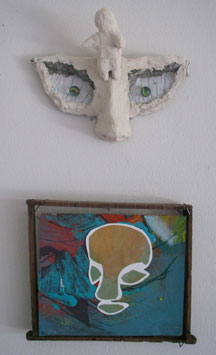 Imagination
Imagination
|
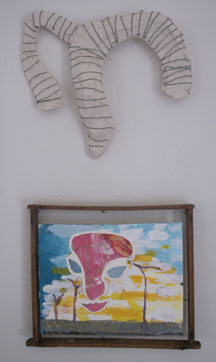 Vacuous
Vacuous |
Everybody wants to be wealthy, honourable, famous, powerful or even mighty, and the weak people will waste away. Mandeville sarcastic writing against the thoughts of the higher society of London in his time later has been taken as a serious concept of the upcoming society.
The objects of Rosa Roedelius stand against this wrong Mandeville interpretation, and that is why she titled the series of paintings ”the truth will make us free”.
|
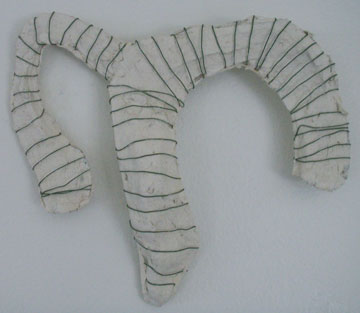
Vacuous (detail)
So we now have the environment, the behaviour, beliefs and values, and all of them are being like one in what we call identity, the next part of this double circle, are the masks. They are representing the subjects, but are they the real subjects? Isn’t always something hidden behind them, for example remember the use of the mask in the classical theatre or in so called primitive religions? Isn’t it a bit of the same, when we are today playing our roles in the big or small games in our so-called real world?
|
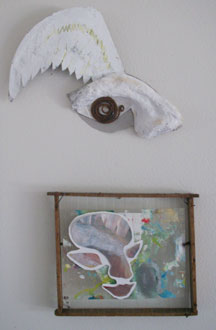 Free or Not
Free or Not |
Coming to you from Vienna, the city of Freud and the birthplace of psychoanalysis and the beginning of now more than 100 years of psychological research, which have opened up the deeper structures of the human mind. But did this help us to understand ourselves better in a basic way, or isn’t it a fact in the meantime, that the psychological point of view since a long time has been transferred into our ordinary way of thinking and therefore lost its sharpness? Haven’t we lost the magic of these methods? There always has to be a symbolic covering of the sine qua non, a how to deal with the last questions, like the religious answers are, and like of course, the questioning of the contemporary art is, which are trying to point out, that maybe it is only a lie, that there is anything secure in life except its ending, and that there only remains the hope, which dies in the end as we all know.
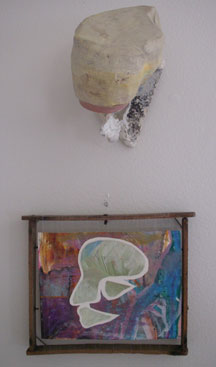 Humbleness
Humbleness |
What can give us the security to solve this horror vacui. There is a childish certainty to Rosa Roedelius, that this power is called love, the only power that last never-ending.
That is the sphere of the masks, they are here and not, are they hidden faces, showing up double binds of the self and the being, not knowing if the individual play is covert up or if it will be accepted by the others, and which are the rules and who is making them? Without love there is no answer to this questions.
|
I am writing as a philosopher. I have to have professional doubt about all systematically tries to force what we call reality into a simplifying structure. In German we make an essential difference between the notion reality, the world of facts and the notion Wirklichkeit, which means fundamental effectively of everything and all in its substantial own way. Reality means all that can be quantified or qualified. But because every notion contains its own negativity as basic contradiction in itself, nothing can be named without defining the opposition in the same time.
|
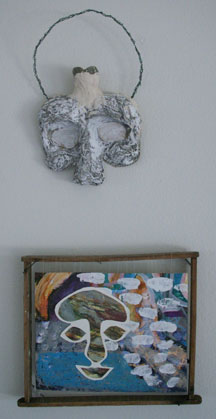 Lights the Crown
Lights the Crown |
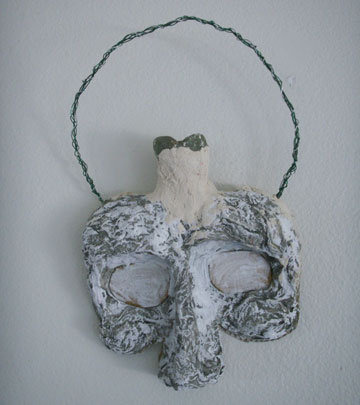
Lights the Crown (detail)
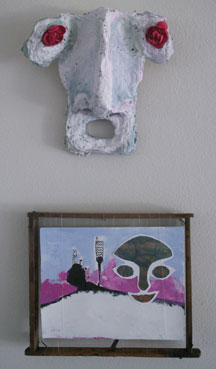 Filled with Wonder
Filled with Wonder |
No one lives his or her life on the base of probability. This category only exists in the scientific universe, which no living being has ever entered. The beliefs and our self-established identity are giving us the fundament and the vision of our personal way to go, these are the signs that are guiding us.
|
And I am so glad that Rosa’s work is expressing such a positive connotation in this matters, like it is said in the title of the paintings: the truth will make us free. That is why the masks and the paintings, like beliefs and identity are so strongly related, that they are almost the same, and that is why the masks and paintings are only sold in common. This nexus is also a political statement, that through all the clouds of lies and the actual bad weather, someday the sunshine will break trough, like the sun always shines here in Southern California.
|
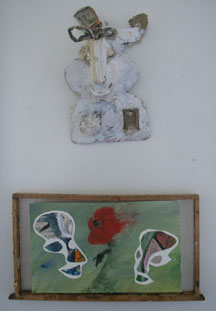 Being Someone
Being Someone |
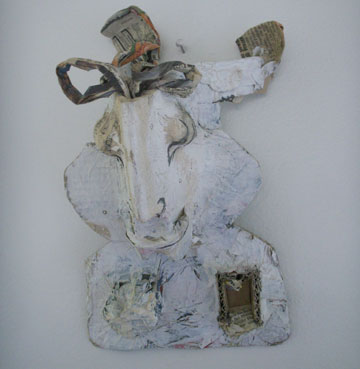
Being Someone (detail)
Finally the 4th circle out there, or better up there, this are the sentinels, the birds. Former symbols of total freedom, being able to move in all direction up in the air, with an easiness and aesthetical move, and giving us the melodies of life, that inspired mankind since the stone ages. But here they are the sentinels, what does this mean?
Why are they, opposite to the other shown works, painted in a naturalistic way? On one hand there is the historical background, that mankind always connected the possibility to fly with the everlasting freedom, or simply being able to fly it would give them an other and better point of view.
Nowadays the birds are getting quiet, maybe because of the pollution, or maybe because of the cell phone radiation, they are wasting away, who knows for how long we will hear them, and then?
It is wonderful which kind of birds Rosa chose, the Nightingale brings to mind Shakespeare's Romeo and Juliet, singing when the sun sets; the Blackbird, another beautiful voice, singing during the daylight; the Quail, who has been a favourite hunted bird and a delicious dish on the kings plate, and finally the Magpie, if she sees something sparkling, she tries to steal it.
Click images for larger view:
So they are the last circle. And what can they see or can see us from up there? The invisible eyes are installed, the iron birds are watching every step and move we make. The forces behind them want to tell us, that all this efforts are just to defend our free community, but by giving up basic civil rights? And all this should look naturally to us, they are trying to sell us bad for good, spinning notions like democracy and freedom, forcing us to withdraw, what our fathers defended against the former totalitarian regimes!
Rosa's vision is, that she wants to make us pay attention to these subjects, that we have to face our liberty, and that it is up to everyone of us to decide, which political system will be established.
Her work is shown here at the Beatrice Wood Center for the Arts, a place, from which in the last century great impulses and influences went out into the world of art and into different societies. The art is still free, it is keeping our minds open, if we come into a dialog with contemporary positions and their new and provocative questionings about the meaning of all this, called life.
Leo Hemetsberger © 2007
Click images for larger view:
|